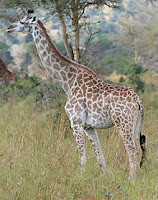Henri Rousseau: Bird drawing

The students love to draw animals, especially birds, For this lesson we use Henri Rousseau Merry Jesters for inspiration. Henri Rousseau (1844 – 1910) was a French artist did not start painting until he was in his 40’s. Ridiculed during his life, he came to be recognized as a self-taught genius whose works are of high artistic quality. He tried to paint in the schooled manner of the traditional artists, but it was the innocence and charm of his work that won him the admiration of many avant-garde artists such as Paul Klee. Rousseau's loving attention to detail that made him an exceptional artist. We use Rousseau “The Merry Jesters” Jungle scene as basis for our lesson. We focus on the large bird sitting on its Jungle perch. The Raptor is surrounded by gigantic leaves. Materials: Heavyweight paper, sketching pencil, watercolor pencils Step #1: Draw light guidelines across the middle and down the center of the page. Draw a circle for the head and oval for the body. ...



